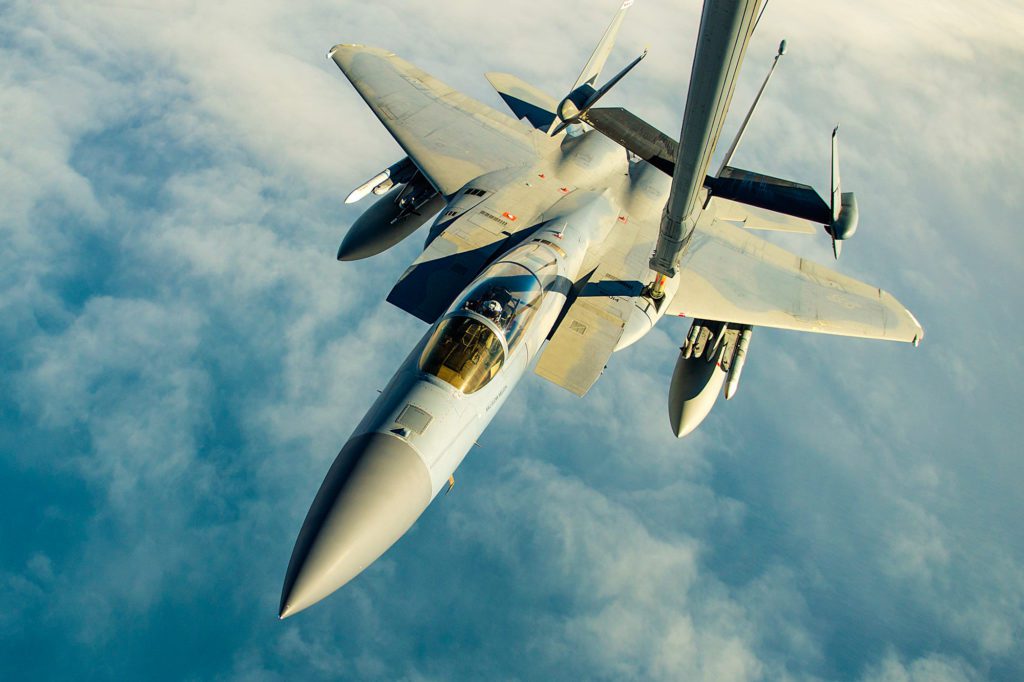
Northern Edge, the biennial U.S. Indo-Pacific Command joint exercise in the far north, will be back in the Gulf of Alaska May 3-14, and for now, at least, military officials are keeping details under wraps.
Air Force Lt. Col. Michael Boyer, the lead planner for Northern Edge, described the war games to reporters in early April as an event that would “allow our younger generations within the armed forces to experience what future conflict could feel like, and the complexities associated with it.”
Northern Edge this year comes in the wake of several incidents of Russian military aircraft encountered near Alaska airspace, more than has been seen in any year since the end of the Cold War, the Air Force Times reported on April 1.
Northern Edge also comes, as usual, just before the start of the Copper River salmon fishery, which is of critical economic and cultural importance to commercial, sport and subsistence harvesters in Prince William Sound. Area residents and other participants in this fishery have expressed concern about the potential adverse impact of the military exercises on the fishery and area wildlife.
The Pacific Air Force is speaking only in generalities about scenarios that are to be part of this year’s exercises, including what weapons will be deployed and steps to ensure environmental protection of marine mammals and other area wildlife. A spokesman for the Pacific Air Force was quoted in the Air Force Times saying the details need to be kept under wraps to “preserve a degree of realism for the participants.”
When asked specifically what weapons will be deployed in the Gulf of Alaska, Capt. Kitsana Dounglomchan, a public affairs officer with the Pacific Air Forces in Hawaii, said his office was unable to provide the specific weapons systems, but that training during the exercises will involve a variety of weapons and munitions systems from both aircraft and surface vessels.
“The Navy’s training activities use an extensive set of mitigation measures designed to minimize potential risks to marine life,” he said.
Measures will be in place of minimize the impact of munitions on the environment, including posting qualified lookouts who observe for marine species during at-sea activities. If marine species are detected training activities will cease until the animal leaves the mitigation area or activities will be delayed until a later time, he said.
Environmental protection, said Dounglochan, is an integral part of the exercise. An environmental impact statement completed in 2011 was reanalyzed for the 2016 exercises in the Gulf and received authorization permits from the National Marine Fisheries Service, he said. Additionally, U.S. Navy bridge personnel, commanding officers, executive officers, maritime patrol aircraft aircrews and anti-submarine warfare helicopter aircrews and lookouts must complete the Marine Species Awareness Training approved for use by NMFS, he said.
These words offer little reassurance, according to the Eyak Preservation Council, which notes that public comment and community council resolutions from coastal communities from Kodiak to Cordova are overwhelmingly against holding these war games in the Gulf in May.
While they are noted as Arctic military training exercises, they are planned to take place when there is more sunlight and generally warmer calmer weather in the Gulf, the council said.
Carol Hoover, a spokesperson for the council, said in her comments to the Navy Command that the Navy must adhere to the concerns voiced by the public, their representatives and the scientific community, to revise its analysis of impacts of these exercises on the Gulf on marine mammals, fish, birds and other marine life, and impose stronger mitigation measures.
“The Copper River Delta and Prince William Sound salmon fisheries have had three disastrous commercial fishing seasons in a row,” said Dune Lankard, a veteran harvester with the Native Conservancy land trust. “Our salmon fisheries are critical to our survival as Native villages and coastal communities, where thousands of fishermen whose livelihoods depend on our unique subsistence and the commercial fishing way of life.”
Marine conservation biologist Rick Steiner contends that, while the Navy has known of these concerns about their military exercises for years, they have done virtually nothing to adjust plans to minimize the impact on marine life in the Gulf. “We have pressed them to initiate real-time environmental monitoring during the drills, accommodate scientific observers onboard during the drills, and to reschedule the drills to winter in order to minimize impacts on salmon, seabirds and marine mammals,” he said. “They have done none of this.”





